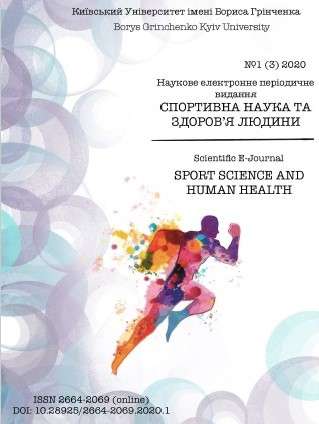INFLUENCE OF VEGETATIVE REGULATION OF HEART RHYTHM ON THE MANIFESTATION OF PHYSICAL PERFORMANCE OF QUALIFIED ATHLETES (І message)
DOI:
https://doi.org/10.28925/2664-2069.2020.1.6Ключові слова:
skilled athletes, heart rate variability, physical loads, cardiorespiratory systemАнотація
Introduction. To assess the characteristics of the body’s adaptation of skilled athletes to strenuous exercise, it is most important to define how the manifestation of physical performance of athletes depend on the autonomic regulation of physiological functions of the body.
Aim is to study the dependence of the autonomic regulation of heart rate on the manifestation of physical performance of qualified athletes and the reaction of the cardiorespiratory system under conditions of physical activity of different nature.
Materials and methods. Determination of physical performance of qualified athletes and the reaction of the cardiorespiratory system (CRS) to test physical activity (ergospirometric complex "Oxycon Pro", treadmill LE-200 C), mathematical analysis of heart rhythm variability, mathematical and statistical methods.
Results. The predominance in the regulation of heart rate activity of the parasympathetic division of the autonomic nervous system helps athletes achieve a higher level of physical performance both in terms of physical activity with a predominance of aerobic processes in energy supply and in terms of maximum realization of aerobic capacity. Increased activity of the parasympathetic division of the autonomic nervous system is combined with a reduced level of VE, which indicates the efficiency of the reaction of cattle under physical conditions, mainly aerobic (low and medium power). With increasing intensity of physical activity (starting from the threshold of aerobic metabolism), the increased level of activity of the parasympathetic division of the autonomic nervous system will increase the level of pulmonary ventilation, which characterizes the most effective response of CRS
Conclusions. The higher level of activity of the parasympathetic division of the autonomic emergency in the regulation of heart rate contributed to the formation of a more economical pattern of respiratory response due to higher VT and lower fT, which under intense physical work allowed to achieve higher levels of VErate regulation, there was a decrease in the efficiency of the respiratory response. Thus, the required operating level VE was formed due to the smaller value of VT at a high level f T and aerobic potential of the athlete. With increasing activity of the sympathetic channel of heart.Посилання
Baevskiy RM, Bersnev EYu, Orlov OI. The problem of assessing human adaptive capabilities in aerospace physiology. Rossiyskiy fiziologicheskiy zhurnal im. I. M. Sechenova. 2012; 98(1):95-107. Russian
Gorst VR, Gorst NA, Polukova MV. Mismatch of the rhythms of the cardiovascular and respiratory systems at maximum physical exertion. Astrahanskiy meditsinskiy zhurnal. 2011;6(2):242-244. Russian
Zaytseva OV, Gureva NS. Initial vegetative status determines the response of the cardiovascular system to changes in the respiratory pattern. Vyatskiy meditsinskiy vestnik. 2007;1:69-70. Russian
Kotelnikov SA, Nozdrachev AD, Odinak MM, Shustov EB. Heart rate
variability: understanding the mechanisms. Fiziologiya cheloveka. 2003;28(1):130-143. Russian
Lysenko OM. Physical performance of qualified athletes and features of autonomic regulation of heart rhythm. Mizhnarodnyi medyko-filosofskyi zhurnal «Intehratyvna antropolohiia» Odeskoho natsionalnoho medychnoho universytetu. 2014;24:48-54. Ukrainian
Lyisenko EN. Key directions of the implementation of the functional capabilities of athletes in the process of sports training. Science in Olympic Sport. 2015;2:45-53. Russian
Mihaylov VM. Heart rate variability. Experience of practical application of the method. Ivanovo; 2000. 200 с. Russian
Mishchenko V., Lysenko OM, Vynohradov VIe. Types of physiological reactivity of the respiratory system and the specifics of the manifestation of special performance of athletes. Physiological Journal. 2006;52(4):69-77. Ukrainian
Mischenko VS, Lyisenko EN, Vinogradov VE. Reactive properties of the cardiorespiratory system as a reflection of adaptation to strenuous physical training in sport. Kyiv: Naukovyi svit; 2007. 351 с. Russian
Pokrovskiy VM. Formation of heart rhythm in humans and animals. Krasnodar: Kuban Kniga; 2007. 144 с. Russian
Polischuk LV. Dependence of the parameters of cardiorespiratory synchronism on the duration of the latent period of a simple sensorimotor reaction. Kubanskiy nauchnyiy meditsinskiy vestnik. 2010;8:159-162. Russian
Potyagaylo EG, Pokrovskiy VM. Features of the phenomenon of synchronization of respiratory and heart rhythms in children with different types of nervous system. Zhurnal vyisshey nervnoy deyatelnosti im. I.P.Pavlova. 2003;53 (1):41-45. Russian
Shynkaruk OA, Lysenko OM, Hunina LM, Karlenko VP, Zemtsova II, Olishevskyi SV, ta in. Medical and biological support for the training of athletes of the national teams of Ukraine in Olympic sports. K.: Olimpiiska lit.; 2009. 144 с. Ukrainian
Shynkaruk O, Lysenko O, Fedorchuk S. Stress and his influence on the competitive and training activities of athletes. Fizychna kultura, sport ta zdorovia natsii: zbirnyk naukovykh prats. 2017;3(22):469-476. Ukrainian
Buitrago S, Wirtz N, Yue Z. Effects of load and training modes on physiological and metabolic responses in resistance exercise. European Journal of Applied Physiology. 2012;112(7):2739-2748.
Fedorchuk S, Tukaiev S, Lysenko O, Shynkaruk O. The psychophysiological state of highly qualified athletes performing in diving with different levels of anxiety. European Psychiatry, Elsevier. 2018;48:681.
Kaikkonen P, Hynynen E, Mann T. Heart rate variability is related to training load variables in interval running exercises. European Journal of Applied Physiology. 2012;112(3):829-838.
Lysenko O, Gasanova S. Particularities of the structure of the functional training degree of athletes-leaders in female boxing. Sport Science and Human Health. 2019;1(1):24-31.
DOI: 10.28925/26642069.2019.1.4
Lysenko O, Fedorchuk S. Reaction of cardiorespiratory system under physical activities of different nature depending on physiological reactivity and fatigue. Sport Science and Human Health. 2019;2:40-45. DOI: 10.28925/2664-2069.2019.2.4
Steele J, Fisher J, McGuff D. Resistance Training to Momentary Muscular Failure Improves Cardiovascular Fitness in Humans: A Review of Acute Physiological Responses and Chronic Physiological Adaptations. Journal of Exercise Physiology online. 2012;5(3):53-80.
Thomas C, Bernard O, Enea С. Metabolic and respiratory adaptations during intense exercise following long-sprint training of short duration. European Journal of Applied Physiology. 2012;112(2):667-675.
##submission.downloads##
Опубліковано
Як цитувати
Номер
Розділ
Ліцензія
Авторське право (c) 2021 Спортивна наука та здоров'я людини

Ця робота ліцензується відповідно до Creative Commons Attribution-NonCommercial-NoDerivatives 4.0 International License.











